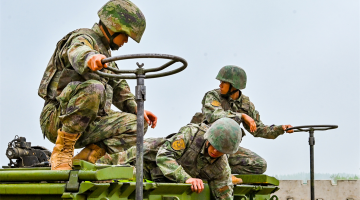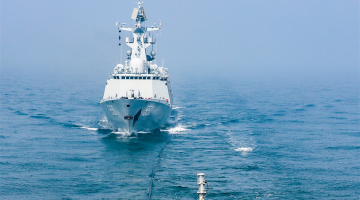By Li Yan
Military transformation is one of the important guarantees for the US to maintain its military superiority after the Cold War. According to RAND Corporation, military transformation refers to profound changes in the military field. These changes are neither fast nor simple improvements of military equipment, but emphasize the overall transformation of the military field and the long process of its evolution. Since Donald Trump came in office, Washington has obviously accelerated its military adjustment and reform, and the basic logic and trend of the new round of military transformation are getting increasingly clear.
To be more specific, firstly, the US has adopted the “threat-based” transformation path. It is a fundamental adjustment of the “capability-based” military development path that started in Rumsfeld’s period as its current resources are not enough to develop “full-spectrum” military capabilities.
The “capability-based” approach places more stress on the independence and flexibility of military plans and aims to foster military capabilities in all key areas. The Trump administration made it clear in the 2018 National Defense Strategy that “long-term inter-state strategic competition” is the central challenge, and claimed “the US should compete with rivals in areas where it is superior to them”. This means “threat-based” approach is America’s choice of military development in the new international environment, which is focused on the strengths and weaknesses of Chinese and Russian militaries to reshape its own military advantages. To that end, various services of the American military have formulated new war theories and combat concepts that are focused on the “central challenge”, such as “multi-domain battle”, “distributed lethality” and “dynamic military deployments”, which have been executed in American military operations gradually.
Secondly, the US has enlarged its military expenditure and scale in parallel in order to address its consistent “poor war preparedness” and financial restrictions since the previous two wars. The Trump administration has taken measures to circumvent the “sequestration” and largely increase military expenditure. The national defense budget has been on the rise every year ever since 2017, amounting to USD750 billion in the 2020 fiscal year, which lays the financial foundation for this round of military transformation. Meanwhile, the White House has changed the military guideline of “less quantity, more quality” that has been implemented since the late period of George Bush Jr.’s term to “equal emphasis on quantity and quality”. The increase of 16,600 troops in 2018 and another 15,600 in 2019 put an end to the continuous shrinkage of American military after 2009, and the original military equipment procurement plan has been expanded across the board.
Thirdly, the US drives military transformation by reforming the national defense management system. The American military has launched probably the largest-scale institutional reform after the Cold War during this round of transformation, covering the Department of Defense (DoD) management system, military establishment, procurement mechanism, and human resources. For instance, DoD has an independent Chief Management Officer (CMO) and the former duties of deputy secretary responsible for procurement, technology and logistics are divided in a bid to raise the efficiency of work and military fund, cut organizational redundancy and control cost.
In view of major-country competition and the changes in the form of warfare, US military has also pushed for the reform of military structure, setting up the US Army Future Command, re-launching the 2nd Fleet, upgrading the Cyber Command and forming the Space Command that’s on the same level as the Unified Combatant Command. Furthermore, on the basis of the previous “Future Force”, US military has reformed the human resource system oriented by the form of warfare to make it suitable to cope with major-country competition and maintain its long-term advantages.
Fourthly, the US is fostering new warfare mode in light of the future form of war. It has obviously accelerated the building of deterrent forces in new space, not only establishing the cyber force ahead of schedule and basically putting in place the ideas, plans and tools of cyber warfare, but also launching them to actual combat on the counter-terrorism battlefield in the Middle East. In addition to forming the Space Command, the US military has also issued the Space Operations, which for the first time confirmed the space as a “domain of battle” similar to the land, sea and air and put forth the concept of “air-space joint operations”, integrating space battle into the joint operation system. Meanwhile, Pentagon has hastened the planning and exploration for combat modes in intelligent conditions, and all military services have formulated the “intelligent development roadmap” to study on a theoretical level how to win future wars in high-tech conditions. Exploring new mode of warfare is a traditional practice of military transformation in American history, which intends to occupy a high ground in future battles by getting a theoretical head-start and form new “intergenerational” advantages over rivals.
Fifthly, the US is reshaping geo-military layout in important strategic directions. In this round of military transformation, the focus of geo-military layout is making good use of existing forces, consolidating current military layout through mode innovations such as global operations, deployment of troops and maneuvering, and guaranteeing military superiority in key regions. Following this concept, the US military, led by the “Indo-Pacific strategy”, is trying to establish a new architecture that besieges and contains regional powers by squeezing their space both from the West Pacific and the Indian Ocean, and seeks to form new geographical advantages on a larger landscape both on land and sea. In this process, Pentagon has paid special attention to enhancing the current military deployments and launching innovative concepts of regional combat. While ensuring traditional approaches like military bases and facilities, it has mobilized new frontier presence and power projection approaches to make its military presence “dynamic” and operations “unpredictable”.
To be continued.
(The author is deputy director of the Institute of American Studies, China Institutes of Contemporary International Relations)









